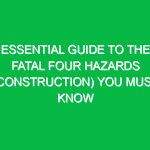“`html
Essential Guidelines to Avoid the Fatal Four Hazards in Construction
Good morning team! Today, we are going to discuss an incredibly important topic that affects each and every one of us on the job site: the Fatal Four hazards in construction. Understanding these hazards and how to avoid them is crucial for our Safety and well-being. Not only can these guidelines help us prevent serious injuries or fatalities, but they also foster a safer work Environment for everyone. Let’s dive in!
Understanding Essential Guidelines to Avoid the Fatal Four Hazards in Construction
The term “Fatal Four” refers to the four leading causes of fatalities in the construction industry: falls, being struck by objects, electrocutions, and being caught in or between objects. According to the Occupational Safety and Health Administration (OSHA), these hazards account for more than 60% of all construction-related deaths. Recognizing and mitigating these risks is essential for keeping ourselves and our coworkers safe.
Many workers might think that accidents won’t happen to them, but that mindset can lead to complacency. It’s crucial to remember that safety is everyone’s responsibility, and being proactive about these hazards can save lives.
Key Hazards, Risks, and Safety Considerations
Let’s break down each of the Fatal Four hazards and explore their risks and safety considerations:
Falls:
Falls are the leading cause of fatalities in construction. They can occur from ladders, scaffolding, roofs, or other elevated surfaces. Even a fall from a low height can lead to serious injuries. Always use Fall Protection systems like guardrails, safety nets, or personal fall arrest systems (PFAS).
Struck by Objects:
This hazard involves being hit by tools, equipment, or materials that are not secured. It can happen when materials are being lifted, moved, or stored improperly. Use hard hats, and ensure that materials are stored securely.
Electrocutions:
Electrocutions occur when workers come into contact with live wires or circuits. This can lead to severe injuries or death. Always use insulated tools and wear appropriate Personal Protective Equipment (PPE) when working near electrical sources.
Caught-in or Between:
This hazard occurs when workers are caught in or compressed by equipment or objects. It can happen when working near heavy machinery or when improper lifting techniques are used. Always use proper lifting techniques and ensure that equipment is properly maintained.
Best Practices, Procedures, & Actionable Advice
Now that we understand the key hazards, let’s discuss the Best Practices to avoid them:
1. Fall Prevention
To prevent falls:
- Always use proper fall protection equipment.
- Inspect scaffolding and ladders before use.
- Maintain clean and organized work areas to minimize tripping hazards.
2. Preventing Struck-by Incidents
To avoid being struck by objects:
- Wear hard hats and other appropriate PPE.
- Follow proper lifting techniques.
- Ensure that all materials are properly secured when not in use.
3. Electrical Safety
For electrical safety:
- Always de-energize circuits before working on them.
- Use GFCI (Ground Fault Circuit Interrupter) protection.
- Keep tools and equipment away from wet areas.
4. Avoiding Caught-in or Between Hazards
To prevent caught-in or between incidents:
- Always be aware of your surroundings.
- Ensure machinery is equipped with proper safety features.
- Communicate with coworkers when working near equipment.
Real-world incidents can serve as powerful reminders of the importance of these guidelines. For example, a construction worker fell from a roof due to lack of proper harnessing, resulting in a serious injury that could have been prevented. By following these safety practices, we can significantly reduce the likelihood of similar incidents.
Regulations, Standards, and Compliance
Compliance with safety Regulations is not just a legal requirement; it’s a moral obligation to protect ourselves and our coworkers. osha sets forth regulations that require employers to provide a safe workplace. This includes providing necessary Training, equipment, and Safety Measures to avoid the Fatal Four hazards.
Understanding these regulations can empower you to advocate for a safer work environment. If you notice unsafe practices or conditions, report them to your supervisor immediately. Remember, safety is a shared responsibility!
Employee Engagement & Discussion
Let’s take a moment to discuss. What safety challenges have you encountered related to the Fatal Four hazards? How can we improve our practices on the job site? Sharing experiences can foster a culture of safety and help us learn from one another.
Conclusion & Key Takeaways
In conclusion, understanding and applying the essential guidelines to avoid the Fatal Four hazards in construction is critical for our safety. Remember to:
- Utilize fall protection equipment.
- Wear appropriate PPE to prevent struck-by incidents.
- Practice electrical safety diligently.
- Stay aware of your surroundings to avoid caught-in or between hazards.
Let’s commit to making safety our top priority every single day. Thank you for your attention and for your dedication to maintaining a safe work environment. Together, we can prevent accidents and ensure that everyone goes home safe at the end of the day!
“`


